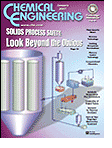Friday, September 18, 2009
Display problem ? Click HERE
Recommended :
- Subscribe FREE - Chemical Engineering
- Tips on Succession in FREE Subscription
 A pump with capacity of 100 m3/h and pump head of 75 m, base on suction drum elevation, fluid condition and suction piping condition, the calculated available Net Positive Suction Head (NPSHa) is 2m. This NPSHa shall be verified with NPSH required (NPSHr) by selected pump.
A pump with capacity of 100 m3/h and pump head of 75 m, base on suction drum elevation, fluid condition and suction piping condition, the calculated available Net Positive Suction Head (NPSHa) is 2m. This NPSHa shall be verified with NPSH required (NPSHr) by selected pump.
- Subscribe FREE - Chemical Engineering
- Tips on Succession in FREE Subscription
How would you know if NPSHa is sufficient before the pump vendor provide the information on pump required Net Positive Suction Head (NPSHr) ?
Thoma Cavitation curve has been used to check as discussed in "Quick Check if NPSHa is Sufficient Using Thoma Cavitation Curve". Present post will discuss the usage of Suction Specific Speed for checking.
Suction specific speed ( Nss) of a pump is a dimensionless number expressed as
Suction specific speed ( Nss) of a pump is a dimensionless number expressed as
Nss = ( N* Q 0.5 ) / (NPSHr)0.75
Where
Nss : Suction Specific speed
Q : Flow rate (gpm) at the Best Efficiency Point
N : Pump rotational speed (rpm) *
NPSHr : Net Positive Suction Head required (ft)
Normal pump speed is 1450 rpm for low speed pump and 2950 rpm for high speed pump.
Soluation
Assumed pump curve is selected where pump flowrate is at best efficiency point
Pump Flow rate
Q = 100 m3/h
Q = 100 m3/h x ( 264.17 Gallon / m3 ) x (1 h / 60 min)
Q = 440.28 gpm
Pump Speed
Same as previous post, N = 2950 rpm for high speed pump
Pump Suction Specific Speed (Nss)
Same as previous post, Nss = 11000 is selected.
From above equation
Nss = ( N* Q 0.5 ) / (NPSHr)0.75
(NPSHr)0.75 = ( N* Q 0.5 ) / Nss
NPSHr = [( N* Q 0.5 ) / Nss](1/0.75)
NPSHr = [( 2950* 440.28 0.5 ) / 11000](1/0.75)
NPSHr = 10.009 ft = 3.05 m
Calculated NPSHr if 3.05 m is very close to NPSHr of 3.0 m as estimated using Thoma Curve. NPSHa of 2m is lower than NPSHr of 3.05m. Obviously the pump potential cavitate under normal operation as NPSHa less than NPSHr. Quick action to rectify the drum elevation & pump suction piping design may required to avoid potential future change.
Related Topic
Soluation
Assumed pump curve is selected where pump flowrate is at best efficiency point
Pump Flow rate
Q = 100 m3/h
Q = 100 m3/h x ( 264.17 Gallon / m3 ) x (1 h / 60 min)
Q = 440.28 gpm
Pump Speed
Same as previous post, N = 2950 rpm for high speed pump
Pump Suction Specific Speed (Nss)
Same as previous post, Nss = 11000 is selected.
From above equation
Nss = ( N* Q 0.5 ) / (NPSHr)0.75
(NPSHr)0.75 = ( N* Q 0.5 ) / Nss
NPSHr = [( N* Q 0.5 ) / Nss](1/0.75)
NPSHr = [( 2950* 440.28 0.5 ) / 11000](1/0.75)
NPSHr = 10.009 ft = 3.05 m
Calculated NPSHr if 3.05 m is very close to NPSHr of 3.0 m as estimated using Thoma Curve. NPSHa of 2m is lower than NPSHr of 3.05m. Obviously the pump potential cavitate under normal operation as NPSHa less than NPSHr. Quick action to rectify the drum elevation & pump suction piping design may required to avoid potential future change.
Related Topic
- Facts About NPSH - Cavitation Even NPSHa More than NPSHr ?
- Protect Pump for Longer Operation
- Basis & Tips on Setting Centrifugal Pump "Warming" Recycle Flow
- Flow-Delta P Protection Strategy
- Centrifugal Pump Minimum Flow Control Strategies
- Quick Check Pump Performance Using Motor Data and Field Measure Current
- Is PumpSmart Right Solution for You ?
- Vortex Breaker to Avoid Vapor Entrainment
Labels: Pump
0 Comments:
Post a Comment
Let us know your opinion !!! You can use some HTML tags, such as <b>, <i>, <a>
Subscribe to Post Comments [Atom]
Home:
<< Home